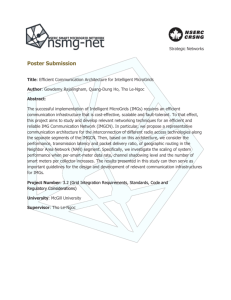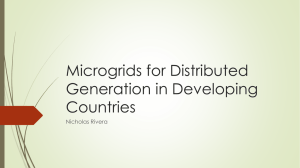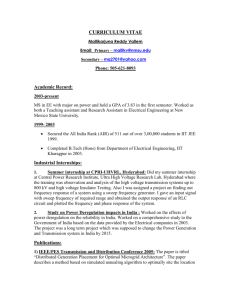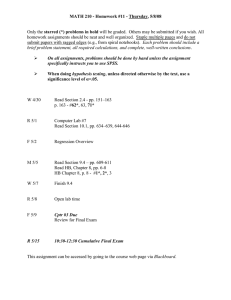Syllabus - University of Pittsburgh
advertisement
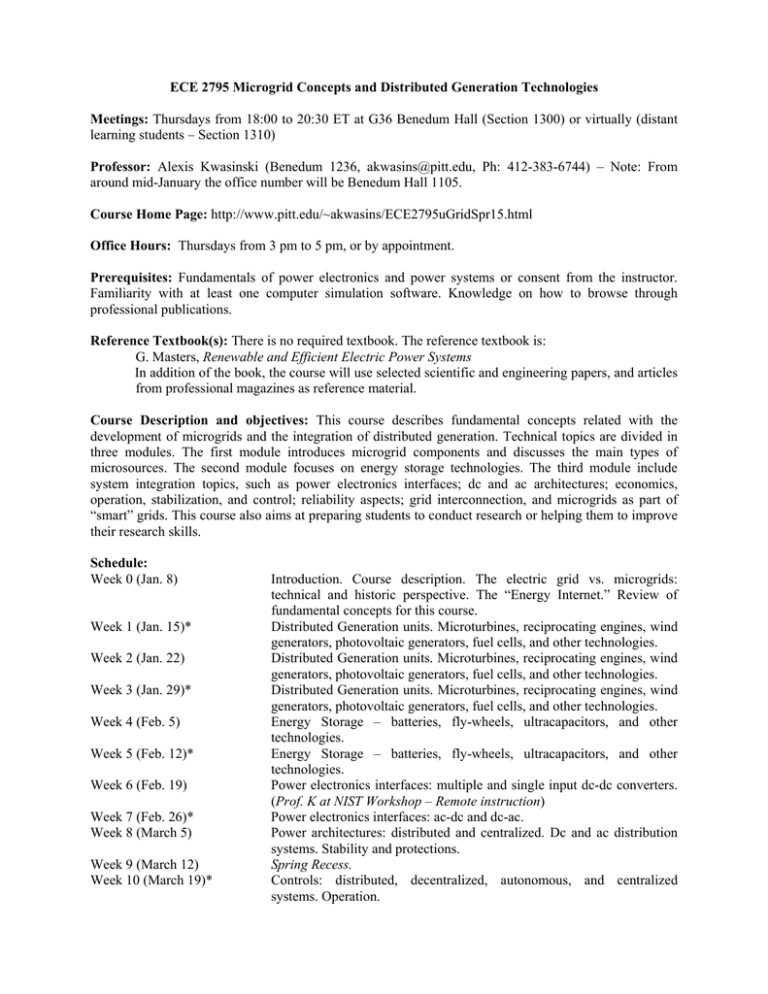
ECE 2795 Microgrid Concepts and Distributed Generation Technologies Meetings: Thursdays from 18:00 to 20:30 ET at G36 Benedum Hall (Section 1300) or virtually (distant learning students – Section 1310) Professor: Alexis Kwasinski (Benedum 1236, akwasins@pitt.edu, Ph: 412-383-6744) – Note: From around mid-January the office number will be Benedum Hall 1105. Course Home Page: http://www.pitt.edu/~akwasins/ECE2795uGridSpr15.html Office Hours: Thursdays from 3 pm to 5 pm, or by appointment. Prerequisites: Fundamentals of power electronics and power systems or consent from the instructor. Familiarity with at least one computer simulation software. Knowledge on how to browse through professional publications. Reference Textbook(s): There is no required textbook. The reference textbook is: G. Masters, Renewable and Efficient Electric Power Systems In addition of the book, the course will use selected scientific and engineering papers, and articles from professional magazines as reference material. Course Description and objectives: This course describes fundamental concepts related with the development of microgrids and the integration of distributed generation. Technical topics are divided in three modules. The first module introduces microgrid components and discusses the main types of microsources. The second module focuses on energy storage technologies. The third module include system integration topics, such as power electronics interfaces; dc and ac architectures; economics, operation, stabilization, and control; reliability aspects; grid interconnection, and microgrids as part of “smart” grids. This course also aims at preparing students to conduct research or helping them to improve their research skills. Schedule: Week 0 (Jan. 8) Week 1 (Jan. 15)* Week 2 (Jan. 22) Week 3 (Jan. 29)* Week 4 (Feb. 5) Week 5 (Feb. 12)* Week 6 (Feb. 19) Week 7 (Feb. 26)* Week 8 (March 5) Week 9 (March 12) Week 10 (March 19)* Introduction. Course description. The electric grid vs. microgrids: technical and historic perspective. The “Energy Internet.” Review of fundamental concepts for this course. Distributed Generation units. Microturbines, reciprocating engines, wind generators, photovoltaic generators, fuel cells, and other technologies. Distributed Generation units. Microturbines, reciprocating engines, wind generators, photovoltaic generators, fuel cells, and other technologies. Distributed Generation units. Microturbines, reciprocating engines, wind generators, photovoltaic generators, fuel cells, and other technologies. Energy Storage – batteries, fly-wheels, ultracapacitors, and other technologies. Energy Storage – batteries, fly-wheels, ultracapacitors, and other technologies. Power electronics interfaces: multiple and single input dc-dc converters. (Prof. K at NIST Workshop – Remote instruction) Power electronics interfaces: ac-dc and dc-ac. Power architectures: distributed and centralized. Dc and ac distribution systems. Stability and protections. Spring Recess. Controls: distributed, decentralized, autonomous, and centralized systems. Operation. Week 11 (March 26) Week 12 (April 2)* Week 13 (April 9) Week 14 (April 16) Week 15 (April 23) Reliability and availability. (Remote instruction likely) Economics. Grid interconnection. Issues, planning, advantages and disadvantages both for the grid and the microgrid. Microgrids as part of smart grids. Student projects discussion (part 1) Student projects discussion (part 2) Note about the schedule: Italics indicate weeks when the instructor will be attending conferences or may be unable to teach from the classroom. However, some additional trips unknown at this time may come up during the course of the semester. For example, due to the particular nature of his research Dr. K may need to travel to disaster areas on short notice. Although Dr. K will communicate these trips in advance along with any potential changes that these trips may cause, it is not possible to know at this time when those trips may occur. Still, provisions will be taken so no lecture classes are missed. Asterisks indicate weeks when homework assignments are likely to be assigned (or, in most cases, to be due). Grading: Homework: 35% Project preliminary evaluation: 15% Project report: 25% Project discussion: 15% Class participation: 10% Letter grades assignment: 100% – 96% = “A+”, 95% – 91% = A, 90% – 86% = A-, 85% – 81% = B+, and so on. Homework: This course does not have conventional tests. Instead, homework assignments tend to be somewhat more comprehensive than typical homework assignments you were used to have during your undergraduate studies. For this reason, homework will be assigned about every two weeks and you will have about that time to work on the problems. Sometimes, homework problems will also require students to find solutions with minimal guidance from the instructor. The goal of this approach for homework assignment planning is for students to learn how to find paths for solutions to problems. Many times there could be many paths that will lead to solving a problem and sometimes there will be many equally valid solutions for a given problem. Making mistakes is part of the learning process. For this reason the lowest score for an assignment will not be considered to calculate the homework total score. However, in order to have your lowest homework score discarded, you will need to attempt to solve all homework assignments which means that your lowest homework score will be discarded only if you submit all homework assignments showing a good-faith effort in solving the problems. Since some homework problems may have different valid solutions or different paths to a solution, the focus when I grade homework assignments is more on the process taken to address the problem and not so much on a numerical answer. Hence, it is very important that homework problem solutions explain clearly but concisely the path taken to find the solution to a given problem and that students include some brief discussion explaining their answer to each homework question. Additionally, please, expect about couple of weeks grading cycle for homework assignments as both the content and the grading approach require extra time in order to perform a fair assessment of the completed work. Project: This course also includes a project that will require successful students to survey current literature and to analyze a problem. The project consists of carrying out a short research project throughout the course. For this project, students need to identify some topic related with microgrids and study it throughout the course. Examples of valid topics are the study of a microgrid power generation technology, integration of energy storage in microgrids, planning and design of microgrids, stability and control of microgrids, use of microgrids in a particular application, performance evaluation of microgrids, etc. Examples of topics that may likely be unsuitable for this course include the study of large wind or PV farms, technologies or operation of conventional power systems with a weak connection to microgrids, integration of microgrid technologies from the perspective of conventional power grids, smart grid or new power grid-related technologies (e.g. electric vehicles) with a weak connection to microgrids, etc. That is, this is a course about microgrids, not general power systems or conventional power grids, so the project needs to reflect this focus on microgrids). The project is divided in three phases: 1) Preliminary phase. Due date: February 12. Submission of references, description of the problem, and proposed approach to study it (1 to 2 pages long-single column document). 2) Second phase. Due date: April 2. Submission of a short paper (the report), at most 10 pages long, single column. 3) Discussion phase: By April 10 all reports will be made available to the rest of the class. By April 15 every student needs to submit a 1 or 2 sentence long question or comment for each of 5 project reports prepared by fellow students. On April 10, Dr. K will assign which are these 5 other projects that each student needs to focus on. We will use these questions or comments during the Q&A session during the discussion of the projects on April 16 and April 23. Participation: Participation points are assigned at instructor’s discretion based on the perceived attitude of individual students towards learning during the semester. Projects discussion: The last two classes of the semester will be dedicated to discuss the projects with the entire class. In these classes, each student will initially have a few minutes (e.g. 3 to 5 minutes) to explain what was the project about and what were the main concepts learned while working on the project. This short presentation will be followed either by a short Q&A session or by a presentation of another project on the same or related topic (which, then, will be followed by a short Q&A session). Part of the goal of assigning a semesterlong report is for students to learn with a little more detail some specific topic related with microgrids. The goal of discussing these projects with the rest of the class is for others to learn a little more about such topic, too. Hence, grading for this portion of the course will depend on how well you can summarize your projects and your participation during the Q&A sessions. When participating in the Q&A sessions it is important not only to be engaged and to, actually, participate in the discussions, but also how well you participate. I.e., quality of the questions and answers are very important. Dr. Kwasinski, as the moderator of the discussion will use the previously submitted questions or comments to guide the discussion. Submission of completed assignments and communications Since this is a course with a distant learning component and just to be a little more friendly with the environment, please, submit all of your assignments electronically in CourseWeb/Blackboard in a single pdf file. In case you have some trouble submitting the document with CourseWeb/Blackboard, you can alternatively send me a message with the pdf file attached. Very important: when sending me a message related with this course start your Subject line with “ECE-2795 S15:” Class presentations and homework assignments will be posted in both CourseWeb/Blackboard and the course website. Announcements will be posted in the course website and in most cases in CourseWeb/Blackboard, too. So, please, check both CourseWeb/Blackboard and the class website regularly for information, class notes and homework assignments. Disclaimers: Although unlikely, this syllabus and course topics may change according to my judgment as to what is best for the class. Any changes will be declared in class. For example, due to the particular nature of my research I may need to travel to disaster areas on short notice. Although I will communicate these trips in advance along with any potential changes that these trips may cause, it is not possible to know at this time when those trips may occur. General course schedule and administrative deadlines follow the University of Pittsburgh Academic Calendar 2014-2015 found at http://www.provost.pitt.edu/documents/ACADEMIC%20CALENDAR%202014-2015%20Final.pdf. University Policies: Academic Integrity University official statement: Students in this course will be expected to comply with the University of Pittsburgh's Policy on Academic Integrity (http://www.provost.pitt.edu/info/ai1.html). Any student suspected of violating this obligation for any reason during the semester will be required to participate in the procedural process, initiated at the instructor level, as outlined in the University Guidelines on Academic Integrity. This may include, but is not limited to, the confiscation of the examination of any individual suspected of violating University Policy. Furthermore, no student may bring any unauthorized materials to an exam, including dictionaries and programmable calculators. My additional statements: Each student in this course is expected to abide by this Academic Integrity Policy. Any work submitted by a student in this course for academic credit will be the student's own work. A good explanation of what constitutes plagiarism can be found in the following IEEE’s web page: http://www.ieee.org/publications_standards/publications/rights/ID_Plagiarism.html. Notice that paraphrasing could be considered a case of plagiarism. Finally, please be wise. Dishonesty is never worth it. Disability Services If you have a disability for which you are or may be requesting an accommodation, you are encouraged to contact both your instructor and Disability Resources and Services (DRS) (http://www.drs.pitt.edu/), 140 William Pitt Union, (412) 648-7890, drsrecep@pitt.edu, (412) 228-5347 for P3 ASL users, as early as possible in the term. DRS will verify your disability and determine reasonable accommodations for this course. Copyright Notice Course materials may be protected by copyright. United States copyright law, 17 USC section 101, et seq., in addition to University policy and procedures, prohibit unauthorized duplication or retransmission of course materials. See Library of Congress Copyright Office (http://www.copyright.gov/) and the University Copyright Policy (http://www.cfo.pitt.edu/policies/policy/10/10-04-01.html). Additional personal notice: I will post class presentations both in CourseWeb/Blackboard and the class website. The latter is open to the outside world but it is also a convenient way for students to access these class notes. Still, this material is copyrighted and protected according to the above notice. Other material, such as papers or class notes will only be shared in CourseWeb/Blackboard. In addition of being copyrighted, this material is only intended for students taking this course, so, please, do not distribute it or post it in the “outside world” as it is indicated in the above statement. Statement on Classroom Recording To ensure the free and open discussion of ideas, students may not record classroom lectures, discussion and/or activities without the advance written permission of the instructor, and any such recording properly approved in advance can be used solely for the student’s own private use.
